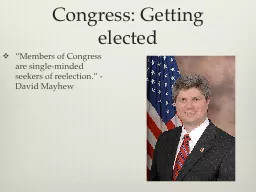

Members of Congress are singleminded seekers of reelection David Mayhew Congress Getting elected Incumbency Advantage Between 1863 and 1969 percentage of first term Reps fell from about 58 to 8 ID: 539511
Download Presentation The PPT/PDF document "Congress: Getting elected" is the property of its rightful owner. Permission is granted to download and print the materials on this web site for personal, non-commercial use only, and to display it on your personal computer provided you do not modify the materials and that you retain all copyright notices contained in the materials. By downloading content from our website, you accept the terms of this agreement.
Slide1
Congress: Getting elected
“Members of Congress are single-minded seekers of reelection.” - David MayhewSlide2
Congress: Getting elected
Incumbency AdvantageBetween 1863 and 1969 percentage of first term Reps. fell from about 58% to 8
%
Incumbents
win between 90-95% of the timeThey win big - incumbents in House elected by 60% or more = 82.2% (2004)Slide3
Congress: Getting elected
Incumbency AdvantageHouse between 2000-2010 = 94.11%
Senate = 84.5%
Why are these numbers so high?Slide4
Congress: Getting elected
Why are these numbers so high? Redistricting
Why did Mike win?Slide5
Congress: Getting elected
Why are these numbers so high? Redistricting
Decline in party voting
Republicans in the mid-1990’s
Why did Mike win?Slide6
Congress: Getting elected
Why are these numbers so high? Redistricting
Decline in party voting
Advertising
Name recognition
Why did Mike win?Slide7
Congress: Getting elected
Why are these numbers so high?Redistricting
Decline in party voting
Advertising
Credit Claiming Case Work - Pork BarrelSlide8
Congress: Getting elected
Why are these numbers so high? Redistricting
Decline in party voting
Advertising
Credit Claiming Money Slide9
Congress: Getting elected
Why are these numbers so high? Redistricting
Decline in party voting
Advertising
Credit Claiming Money Weak Opponents
Who is this guy?Slide10
Congress vs. Parliament
What is the difference between Congress and Parliament?Slide11
Congress vs. Parliament
What is the difference between Congress and Parliament?Candidate centered elections vs. Party centered elections Slide12
Congress vs. Parliament
What is the difference between Congress and Parliament?Candidate centered elections vs. Party centered elections
Party line voting
Power – members of Parliament have little Slide13
Congress vs. Parliament
Power – members of Parliament have little No office, no staff, little
pay
Members of Congress
Represent people, propose legislation$150,000
Staff allowance (avg. 22)Slide14
Congress: What do they do?
Functions:Lawmaking
111th Congress 10,621 bills introduced
383 passed
113 Congress passed 252 laws Slide15Slide16
Congress: What do they do?
Functions:Lawmaking
OversightSlide17
Congress: What do they do?
Functions:Lawmaking
Oversight
Committee Review
CaseworkLegislative AuditSunset Laws
BudgetSlide18
Congress: What do they do?
Functions:Lawmaking
Oversight
RepresentationSlide19
Congress: Representation
How do members of Congress behave? (3 views)
Representational
Focus on reelection
leads them to please their constituentsSlide20
Congress: Representation
How do members of Congress behave? (3 views)
Representational
Focus on reelection leads then to please their constituents
Organizational When constituency issues are small, members follow the cues of their colleagues. Party plays a big roleSlide21
Congress: Representation
How do members of Congress behave? (3 views)
Representational
Focus on reelection leads then to please their constituents
Organizational When constituency issues are small, members follow the cues of their colleagues. Party plays a big roleAttitudinal
personal ideology plays a role in decision makingSlide22
Congress: Representation
Two Constituencies
1) in District
2) in Congress
District ConstituencyGeographic: The DistrictReelection: The SupportersPrimary: The Strong Supporters
Personal: Family and FriendsSlide23
The Filibuster
Filibuster – a Dutch word meaning PirateSenate has a history of unlimited debate
1841 – First filibuster
1917 – Rule 22 adopted
Cloture voteSlide24
The Filibuster
Cloture – a vote to end debateOriginally required a 2/3rds vote
Lowered to 3/5
th
in 1975Slide25
The Filibuster
The Filibuster recordStrom Thurmond (SC) = 24 hours, 18 minutes
Against the Civil Rights Act of 1957Slide26
The Filibuster
The Modern Filibuster rules are differentYou no longer have to actually hold the floor
A minimum of 41 senators need to announce their intent to filibusterSlide27
The Filibuster
Other Senate business can continue but a vote can be delayed without actual floor debateAs a result the filibuster use is on the riseSlide28Slide29
Congressional Ethics – an oxymoron?
Senate:
Gifts: nothing more than $100
Lobbyists: can give gifts, pay for travel, legal defense fund
Fees: can’t charge lecture feesOutside earned income: can’t exceed 15% of Senators salaryLobbying delay of one year
Mass Mailings: can’t exceed $50,000Slide30
Congressional Ethics – an oxymoron?
House:Gifts: Not more
than
$100
Lobbyists: no gifts or travel costsTravel: Others can pay the costs if for official businessFees: Same as Senate
Ex-members must wait 1 year before lobbying